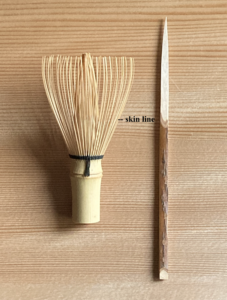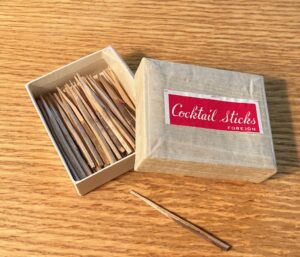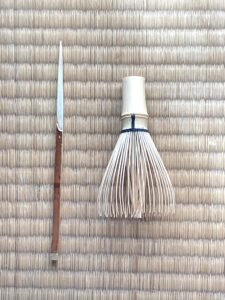Chasen and Kuromoji

Removing the skin or bark from a plant is called kawa-nuki, 皮抜き, skin-peel. The length of the chasen is 3 sun kujira-jaku (11.4 cm). The bamboo cha-sen, 茶筅, tea-whisk, has the thin surface skin of the tine-end removed to a length of 1.33 sun kujira-jaku. The length of the remainder of the tines and handle end that has the skin intact is 1.65 sun kujira-jaku. The ratio between lengths of 1.33 and 1.65 is 8:10. The inner ring of the tines of the chasen comes to a point, or ten, 點, point, the handle end is a contrasting circle.
The length of the tines from the thread binding is 1.8 sun kujira, the length of the handle from the thread is 1.2 sun kujira-jaku. The ratio between the tines and the handle is 10:6.666 to infinity. The number 6, roku, 六, is symbolic of Infinity in Time. The number 6 is also emblematic of water. The turtle that lives for 10 thousand years, with its shell of hexagonal plates, is a water creature. The number 3 is emblematic of fire, e.g., the word pyramid is based on pyro, fire. The flared tines are emblematic of the number 8, hachi, 八, which is sue-hiro, 末広, ends-wide, and emblematic of Infinity in Space. The tines of the chasen is a circle of many points and an inner point/circle, the handle end is a continuous circle, which is also emblematic of infinity, as it has only one side.
The kuro-mo-ji, 黒文字, black-character-letter, the spicebush wood pick, has a square cross-section, and a length of 6 sun kane-jaku (15 cm). Part of its bark and some of the flesh is removed to form a point, and has a small area removed from the handle end. The length of the bark-less pointed end including the handle-end piece is approximately 2.7 sun kane-jaku. The length of the handle with bark intact is 3.3 sun kane-jaku. The ratio between 2.7 and 3.3 is 8:10. This is the same ratio as that of the chasen.
The chasen, used by the host, penetrates the tea. The kuromoji, used by the guest, penetrates the sweet. The chasen is cylindrical, which has the aspect of negative In, 陰, Yin, receptive, and the kuromoji is a straight stick, which has the aspect of positive Yō, 陽, Yang, penetrative. The chasen handle end is a circle, In, the kuromoji end is square, Yō.
The structure of the chasen is similar to the kuromoji in that they both come to a point. However, the chasen is circular and hollow, the kuromoji is square and solid.

The scientific name for kuromoji is Lindera umbellata, also known as spicebush, is a deciduous shrub native to Japan that has many uses in traditional medicine of China and Japan. Kuromoji has also gained popularity in self care products for skin and hair.

The host of Chanoyu, tei-shu, 亭主, house-master, holds the chasen with the right hand to combine the cha, 茶, tea, with yu, 湯, hot water, for the kyaku, 客, guest, to consume. The teishu offers o-ka-shi, お菓子, hon.-sweet-of, and a kuromoji to the kyaku who holds the kuromoji with the right hand to pierce and divide the okashi to consume it. The teishu keeps the chasen, the kyaku keeps the kuromoji as an souvenir, o-miyage, お土産, hon.-earth-product.
The root end of bamboo whisk is discernible because the fushi, 節, node, indicates the growth direction. The tines are symbolic of the bamboo roots, the whisk ‘grows’ out of the tea. The growth direction of the kuromoji may be possible to discern scientifically. However, the handle end of the pick retains the bark, and the part that touches the okashi has the bark removed and tapered. The chasen has the same proportions as the kuromoji. The handles of both the chasen and the kuromoji are at opposite ends.
Tea is prepared by the host and presented to the guest in a cha-wan, 茶碗, tea-bowl. The chawan is a treasured object – the tea is consumed by the guest. The sweet, offered by the host, is placed by the guest on a sheet of her or his own kai-shi, 懐紙, heart-paper, and eaten with the kuromoji presented by the host. The sheet of paper is discarded, the kuromoji is kept by the guest as a souvenir.

